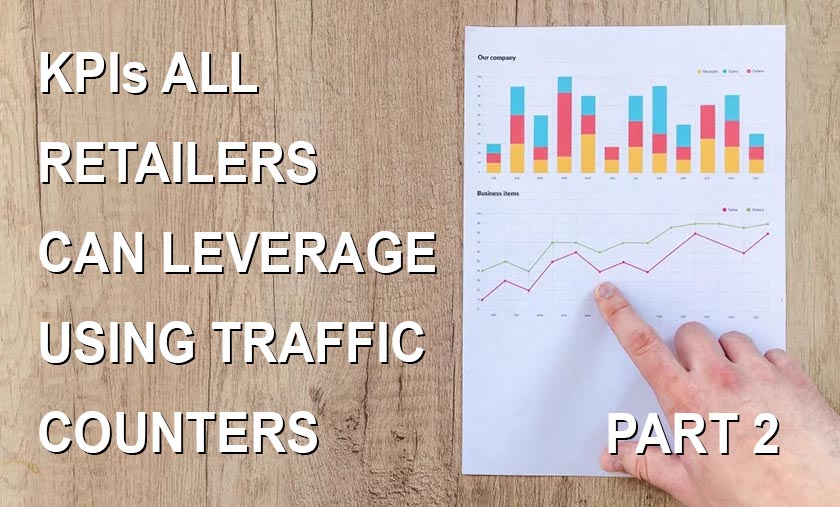
This the 2nd part of a 4 part series that covers the most relevant KPIs retailers can monitor through Prodco’s Traffic Counting Solutions.
Last time, we talked about:
Door Counts: The number of people entering the store
Passer-by Traffic: Direct customer opportunities that pass by the store
Capture rate: The store’s capacity to attract visitors
Make sure to read part 1 first.
Like many KPIs we are covering, it is important to be aware that this data requires your equipment to have integrated WiFi. Fortunately, Prodco’s modern Stereoscopic 3D cameras include WiFi as a basic feature.
4. Average Visit Duration
The Average Visit Duration (AVD) is a KPI that showcases the average time every visitor stayed at a specific location. In other words, that’s how long people are spending on average in your store.
The average visit duration can help benchmark the stores in order to compare the average visit time across the entire retail chain.

The AVD can be, in many cases, set up as a goal on its own. As an example, a company trading in the makeup industry will seek to make its customers sit down and try makeup on, contributing to more time spent in the store. In the same way, an apparel specialist will want its customers to spend time in the fitting rooms, leading to more sales.
5. Engagement Rate
This input breaks down the number of visitors that stayed longer than a specified duration. This is used to measure the level of customer engagement on the sales floor. With this KPI, it becomes easier to pinpoint which stores are more likely to convert visitors into customers and which stores could require additional attention.
 Defining the duration time as a threshold is at the management’s own discretion. This number has to be representative of when a customer is considered engaged or not.
Defining the duration time as a threshold is at the management’s own discretion. This number has to be representative of when a customer is considered engaged or not.
In order to increase the engagement rate, it is crucial to ensure that the store has enough sales staff available to assist visitors and plenty of merchandise on the shelves. This is essential to make sure that the store never misses an opportunity to turn a visitor into a buyer.
Engaging your customers with unique experiences
Every retailer wants to offer its customers fast and relevant assistance and to engage them at the right moment. Some made this a top priority and invested a lot of resources to make sure they provide the best customer experience possible. A perfect example is IKEA. The Swedish retailer is known for providing its customers with restaurants and babysitting services while they’re shopping.

Offering an experience only physical stores can provide is a terrific way to give your customers a good reason to keep coming back. Did you know that being able to test products or to try things on is one of the main reasons why people still visit brick-and-mortar stores?
As such, try to make your customers’ journey a unique experience they will remember, by offering, like FAO Schwarz, amazing shopper experiences in your store:
 Piano scene from movie Big (1988)
Piano scene from movie Big (1988)
Customer engagement is all about inviting your customers to interact with your business and your staff, increasing, as a result, the image of the brand. When used to its full potential, a strong customer engagement strategy will improve loyalty, visit recency, conversion rate, average duration time, reduce bounce rate and will ultimately lead to increased sales.
6. Bounce Rate
The term Bounce Rate comes from an online marketing KPI which originated from web traffic analytics. It indicates the percentage of online visitors who went to a specific page (e.g. homepage) of your website and left without visiting any other pages. It reveals the website’s efficiency at retaining visitors.
Thanks to modern Traffic Counting Solutions that integrate WiFi and Bluetooth technologies, this KPI has crossed over and is now available for brick-and-mortar locations.

This metric is provided to physical retailers to evaluate their stores capacity at keeping their visitors engaged. Described in more basic terms, this is the number of visitors that stayed less than a specified duration.
Every retailer can define their own time associated with this metric that they believe is indicative of a bounce (e.g. < 2 min). It will be defined in correlation with the Engagement KPI, therefore one should also consider what an engaged visitor is while defining this number. Likewise, it must reflect the industry, the retail chain’s average visit time, and the location in the best way possible.
This is an essential KPI that offers a very comprehensive overview of how many potential customers leave the store too quickly. Monitoring this specific KPI is a great way to understand when and where to work on increasing customer engagement levels to attract more opportunities that will convert visitors. Optimized service levels are decisive to provide customers with a good shopping experience.
Staff greeting shoppers and effective merchandising will ensure your visitors find what they’re looking for and will help to reduce the bounce rate.
———
The AVD and the Bounce/Engagement Rates are intimately connected. Taking advantage of good engagement opportunities will directly impact all of these KPIs. Increasing customer engagement levels will also boost dwell times, maximize upselling opportunities, lead to increased sales and it will bring you closer to achieving your store goals.

———
Prodco Analytics delivers a comprehensive analysis platform that highlights where opportunities for improvement exist and helps your stores reach their real performance potential. Our retail performance solution delivers a deeper understanding of shopper behavior with real-time analytics at all levels of the operations and marketing team.
